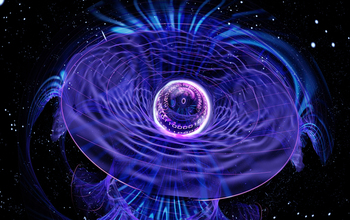Multimedia Gallery
Artist's conception of information falling into a black hole
Artist's conception of information falling into a black hole. Researchers have implemented an experimental test for quantum scrambling, a chaotic shuffling of the information stored among a collection of quantum particles. The experiment was originally inspired by the physics of black holes. Quantum scrambling is one suggestion for how information can fall into a black hole and come out as random looking radiation. Perhaps, the argument goes, it’s not random at all, and black holes are just excellent scramblers.
More about this image
Researchers at the Joint Quantum Institute (JQI) have implemented an experimental test for quantum scrambling, a chaotic shuffling of the information stored among a collection of quantum particles. Their experiments on a group of seven atomic ions demonstrate a new way to distinguish between scrambling, which maintains the amount of information in a quantum system but mixes it up, and true information loss. The protocol may one day help verify the calculations of quantum computers, which harness the rules of quantum physics to process information in novel ways.
The experiment was originally inspired by the physics of black holes. Scientists have long pondered what happens when something falls into a black hole, especially if that something is a quantum particle. The fundamental rules of quantum physics suggest that regardless of what a black hole does to a quantum particle, it should be reversible -- a prediction that seems at odds with a black hole’s penchant for crushing things into an infinitely small point and spewing out radiation. But without a real black hole to throw things into, researchers have been stuck speculating.
Quantum scrambling is one suggestion for how information can fall into a black hole and come out as random looking radiation. Perhaps, the argument goes, it’s not random at all, and black holes are just excellent scramblers. The published study discusses this motivation, as well as an interpretation of the experiment that compares quantum teleportation to information going through a wormhole.
[This research is supported in part by the National Science Foundation (NSF) through the NSF Physics Frontier Center at JQI, and by an NSF Graduate Research Fellowship (grant DGE 17-52814).]
Learn more about this research in the NSF News From the Field story Can entangled qubits be used to probe black holes? or in this JQI news story Ion experiment aces quantum scrambling test. (Date image taken: November 2018; date originally posted to NSF Multimedia Gallery: May 16, 2019)
Credit: E. Edwards/JQI
Images and other media in the National Science Foundation Multimedia Gallery are available for use in print and electronic material by NSF employees, members of the media, university staff, teachers and the general public. All media in the gallery are intended for personal, educational and nonprofit/non-commercial use only.
Images credited to the National Science Foundation, a federal agency, are in the public domain. The images were created by employees of the United States Government as part of their official duties or prepared by contractors as "works for hire" for NSF. You may freely use NSF-credited images and, at your discretion, credit NSF with a "Courtesy: National Science Foundation" notation.
Additional information about general usage can be found in Conditions.
Also Available:
Download the high-resolution JPG version of the image. (1.5 MB)
Use your mouse to right-click (Mac users may need to Ctrl-click) the link above and choose the option that will save the file or target to your computer.



